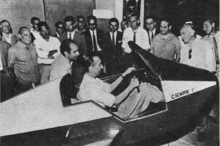Augusto Cicare
Augusto Ulderico Cicaré ( May 25, 1937 in Polveredas – January 26, 2022 in Saladillo ) was an Argentine helicopter designer.
Life
Augusto Cicaré was already interested in technology as a child, so at the age of eleven he built a small motor with which he drove a washing machine and converted a car engine for use with propane gas. At the age of twelve he left school to earn money. He earned his living as a mechanic and was to take over his uncle's workshop. His technical inventiveness continued to grow so that by the age of fifteen he was designing and building a 500cc engine. He wanted to build this into a motorcycle. However, he had to sell it for lack of money. At the age of 18 he invented a two - stroke diesel enginewith 6 hp. This had a stationary cylinder and only three moving parts. In 1965 he was granted a patent for the lubrication system that he had developed for this engine.
Augusto was interested in helicopters from an early age. Although he had never seen an actual helicopter, he worked on it and in 1958 constructed the first helicopter designed and built in South America, the Cicaré CH-1 , which he piloted on its maiden flight in 1961. He taught himself to fly because he didn't have a pilot's license. In 1969, Cicaré designed and built the first flight simulator in South America, for which he received an award. He was constantly working on improving the engines.
In 1970 he founded the company Cicaré Aeronautica SA , which has meanwhile been renamed Cicaré Helicópteros . Until 1974 he constructed two more helicopters, the CH-2 (first flight 1964) and the CH-3 (first flight 1976) on behalf of the Argentine military, which did not go into series production due to lack of money.
In the late 1960s, Cicaré also designed a V-4 engine for use in passenger cars, and the engine was extensively tested by racing driver Juan Manuel Fangio . A version of the engine was intended to be installed in DKW racing cars , but the company closed, meaning the end of the racing engine. As a result, he designed and improved other engines and helicopters. His big breakthrough came with the CH-7 , a single-seat kit helicopter that initially failed to sell. Nevertheless, Heli-Sport Italy acquired the production rights and, like Augusto Cicaré, continued to develop this helicopter, which i.a. was equipped with a new cabin, so that the CH-7, whether from Cicaré or Heli-Sport , became one of the most successful in its class.
In 1996 the Cicaré SVH-3 helicopter simulator came onto the market as another innovative idea of Augusto Cicaré. A new model has recently appeared, the Cicaré SVH-4 . Other helicopter designs followed, such as the two-seater light observation helicopter Cicaré CH-14 on behalf of the Argentine Air Force.
Although Augusto Cicaré had retired from operational business some time ago - two of his three sons now run the company - he was still working on the construction of other helicopters at the age of 80.
honors

- 1969 The Argentine Ministry of Education and Culture awarded him the title of Maestro Técnico (technical master – similar to engineer).
- In 1996 he was honored as a Friend of the Argentine Air Force. Argentine President Carlos Menem personally presented the diploma.
- In 1997 he was awarded an honorary doctorate for his achievements in aviation.
- In 1999 he was made an honorary citizen of the province of Buenos Aires .
He has received many other prizes and awards.
literature
- Halbritter, Franzisco: De Saladillo al mundo Augusto Cicaé y sus helicópteros , 2009, ISBN 978-987-22293-5-1
- Marc Volland: The planes from Embraer: and other Latin American aircraft manufacturers from 1945 , p. 22 ff, ISBN 978-3-8423-0004-0
web links
- Augusto Cicaré at cicare.com.ar (Spanish) Retrieved March 2, 2017
- Cicaré Helicópteros SA at taringa.net (Spanish) retrieved on March 2, 2017
- Augusto Cicaré, a los 80 años: “Todavía sigo aprendiendo” at autoblog.com.ar (Spanish) retrieved March 2, 2017
- Augusto Cicaré: la historia del emprendedor que hace helicópteros desde Saladillo para el mundo at lanacion.com.ar (Spanish) accessed 2 March 2017
- Who was Augusto Cicare? Retrieved from tinkersource.com on March 2, 2017
itemizations
- ↑ Adiós a Augusto "Pirincho" Cicaré: falleció el genio de los helicópteros argentinos. Retrieved January 26, 2022 (es-ar).
- ↑ a b Marc Volland: The planes from Embraer: and other Latin American aircraft manufacturers from 1945 , p. 22 ff, ISBN 978-3-8423-0004-0
- ↑ a b c d e f g h i j Augusto Cicaré at cicare.com.ar accessed 22 February 2017
- ↑ Augusto Ulderico Cicaré – Un genio anda suelto , Revista Automundo Nº 280. September 15, 1970 (Spanish), retrieved March 18, 2017
- ↑ El Chacarero y Los Fierros Revista La Chacra, December 1, 1968
- ↑ CICARÉ Y FANGIO, ADMIRACIÓN MUTUA at enelairesports.com (Spanish) accessed 2 March 2017
- ↑ Augusto Cicaré, a los 80 años: “Todavía sigo aprendiendo” at autoblog.com.ar (Spanish) accessed March 2, 2017
| personal data | |
|---|---|
| SURNAME | Cicare, Augusto |
| ALTERNATIVE NAMES | Ulderico Cicaré, Augusto (full name) |
| BRIEF DESCRIPTION | Argentine helicopter designer |
| BIRTH DATE | May 25, 1937 |
| PLACE OF BIRTH | Polveredas |
| DATE OF DEATH | January 26, 2022 |
| PLACE OF DEATH | El Palomar |




